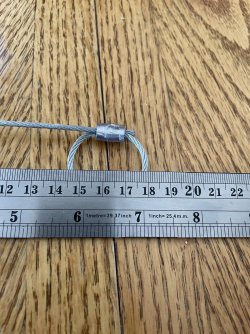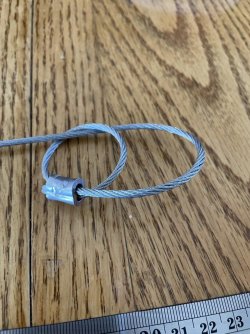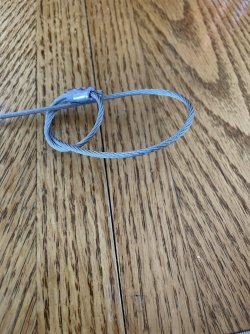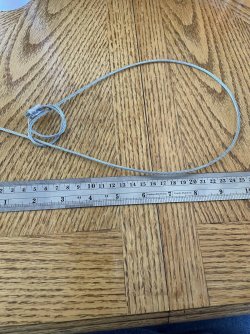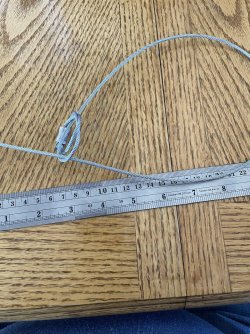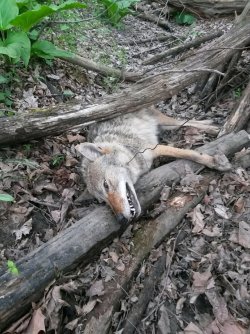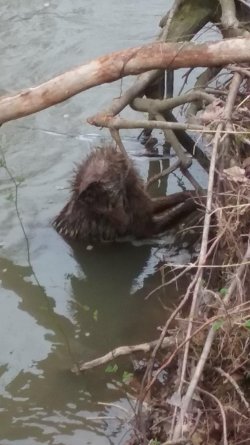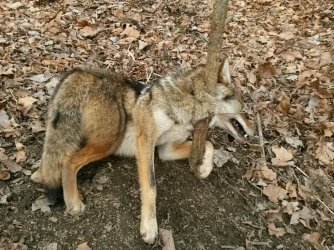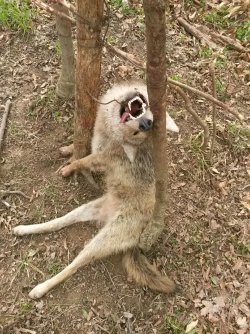People like Vern Dorn, Bill Austin, Keith Gregerson, Slim Pederson, Craig O'Gorman, S. Stanly Hawbecker and many more have all helped so much with most of us being able to advance our skill sets at a faster pace than if we were to try and learn it all on our own. We learn from them and then take what they have shown us and adapt it to our needs, and the areas that we work in. I have seen some very good people in their fields, most that were or are vastly better than me, and some people that were real sh95 shows, out there. A lot of people that were willing to learn and change to do better and a lot of people that thought they knew it all already and couldn't change. A lot of people that trained coyotes well in most ways, and a few that came in and cleaned up after others, quietly doing what they do then moving on to the next problem to be solved. A big hat off to those out there cleaning up after the others and those that are willing to do their best to help others that want to advance their skills, and to the ones that are trying to learn to be better at what we love doing so much!!!!
-
If you are being asked to change your password, and unsure how to do it, follow these instructions. Click here
You are using an out of date browser. It may not display this or other websites correctly.
You should upgrade or use an alternative browser.
You should upgrade or use an alternative browser.
Ramblings and Such From Hunting Coyote
- Thread starter DSheetz
- Start date
 Help Support Long Range Hunting Forum
Help Support Long Range Hunting Forum
The beginning of the knot, the first pass through, the second pass through, so that it holds better and lays right, the cable passed through and under itself-wrong, the knot doesn't lay correctly, and the cable passed under itself correctly, so the knot lays correctly and doesn't stand out a lot as well as locking up right and not trying to unwind the cable that you have passed through and under itself. Simple and effective if you don't have break away restrictions, or if you need food in an emergency. Note that the double ferule is crimped so that the cable lays beside its self-making the cable lay better as you make your first pass through, and thus the rest of the pass's lay better as well. I used them for years and killed a lot of coyote and fox with them. Then the laws in my area changed. Last fall I was showing a younger guy some of my snares when his father-in-law said something to me about my old snares that I used when I first started working for them. The young guy said what did you decide that you needed to abide by the law and stop being an outlaw. I smiled at him and said well when I started working for these guys dad, they were legal, and you hadn't even been thought of let along been born. Times and laws change and so did I and the methods, and equipment I use. His father-in-law said they worked and killed a lot of coyotes for us saved us hundreds of lambs over the years.
Attachments
Bucklowery
Well-Known Member
The beginning of the knot, the first pass through, the second pass through, so that it holds better and lays right, the cable passed through and under itself-wrong, the knot doesn't lay correctly, and the cable passed under itself correctly, so the knot lays correctly and doesn't stand out a lot as well as locking up right and not trying to unwind the cable that you have passed through and under itself. Simple and effective if you don't have break away restrictions, or if you need food in an emergency. Note that the double ferule is crimped so that the cable lays beside its self-making the cable lay better as you make your first pass through, and thus the rest of the pass's lay better as well. I used them for years and killed a lot of coyote and fox with them. Then the laws in my area changed. Last fall I was showing a younger guy some of my snares when his father-in-law said something to me about my old snares that I used when I first started working for them. The young guy said what did you decide that you needed to abide by the law and stop being an outlaw. I smiled at him and said well when I started working for these guys dad, they were legal, and you hadn't even been thought of let along been born. Times and laws change and so did I and the methods, and equipment I use. His father-in-law said they worked and killed a lot of coyotes for us saved us hundreds of lambs over the years.
What size cable and is the ferule only crimped on one side or are both cables crimped at the final
Thanks
Buck
It's 3/32 cable and both cables are crimped in the double ferule so that they lay side by side. My crimping tool is kind of narrow being only a quarter of an inch wide because I made it from a cheap set of bolt cutters, 18.00 dollars verse 70.00 for the crimping tool. In Slim Pederson's book he just used the cable and not the ferule.
trapper1954
Well-Known Member
How about this?

 news.yahoo.com
news.yahoo.com
Cat saves dog from coyote attack
dog is alive and wagging her tail, thanks to the family cat who scared off two attacking coyotes.
HRM Johnny
Well-Known Member
It was an interesting article. I'm not sure what to make of it. But, thank you for posting it.How about this?

Cat saves dog from coyote attack
dog is alive and wagging her tail, thanks to the family cat who scared off two attacking coyotes.news.yahoo.com
HRM Johnny
Well-Known Member
Have you guys heard about the coyote killing seals by biting their heads off? Apparently, for years seals have been found with their heads bitten off. No one knew what was happening. Eventually, someone got a video of coyote, killing a seal. I am sorry, but I don't know how to post a link to an article like Trapper1954 did. If you, Google coyotes, killing seals , you will get a bunch of articles describing it.
trapper1954
Well-Known Member
I could'nt get any actual footage, just scavenging. Lots of articles maybe all same story.Have you guys heard about the coyote killing seals by biting their heads off? Apparently, for years seals have been found with their heads bitten off. No one knew what was happening. Eventually, someone got a video of coyote, killing a seal. I am sorry, but I don't know how to post a link to an article like Trapper1954 did. If you, Google coyotes, killing seals , you will get a bunch of articles describing it.
ohlongarmisle
Well-Known Member
I've used Thompsons for years 1XX 120 usually, if they're loaded well they fire in a millisecond resulting in a snared animal. Reluctant to try anything else after all these years, when I was a kid not even 10 yrs old I used Thompsons 0xx to snare ringneck pheasants ,illegal but nobody cared and all were eaten happily.The beginning of the knot, the first pass through, the second pass through, so that it holds better and lays right, the cable passed through and under itself-wrong, the knot doesn't lay correctly, and the cable passed under itself correctly, so the knot lays correctly and doesn't stand out a lot as well as locking up right and not trying to unwind the cable that you have passed through and under itself. Simple and effective if you don't have break away restrictions, or if you need food in an emergency. Note that the double ferule is crimped so that the cable lays beside its self-making the cable lay better as you make your first pass through, and thus the rest of the pass's lay better as well. I used them for years and killed a lot of coyote and fox with them. Then the laws in my area changed. Last fall I was showing a younger guy some of my snares when his father-in-law said something to me about my old snares that I used when I first started working for them. The young guy said what did you decide that you needed to abide by the law and stop being an outlaw. I smiled at him and said well when I started working for these guys dad, they were legal, and you hadn't even been thought of let along been born. Times and laws change and so did I and the methods, and equipment I use. His father-in-law said they worked and killed a lot of coyotes for us saved us hundreds of lambs over the years.
I started out using the Thompson snares. They were good snares in most cases but in my situation, there were a few places that they weren't exactly what I needed. And yes, if you preload them, they are super-fast, the tree lock end used up more cable than I could handle for my fence snaring, without an extension, with the ones that were available to me in my area, 72" were the ones that I had access to. I also found that the stiffness was more than I liked but all in all they were a good snare. They didn't unwind and expose a lot of smaller wires that were easily chewed through. Having a lower budget, I found that making my own snares was more cost effective for me with the Pederson knot it was a few cents each. 3/32 " aircraft cable was readily available from overhead door installers. The availability has changed since the early 80's and late 70's. In the 90's a lot of places had equipment available by mail order, now we are seeing a slight reversal of availability in quality products. Gregerson snares were the next most readily available snares in my area and if you learned how to adjust the locks they were fast as well, the flaw they had was at times if you didn't get a good fast kill the locks would wear and not hold as well, they were a onetime use lock for sure. The bent washer locks were never a good lock up for me, but they would work. Then came the advent of the cam-locks and some variations of them. Some had aluminum wire as a break away device instead of a rivet for the pivot. then came the s-hook break aways. In the end when we find something that works for us and our specific needs, we should stick with it because what we try next might just be a snare set for us to open our pockets and empty them to the trapper of people, unless we can take a good look at it and analyze what we are looking at. I have always been one that likes to explore new things and look at other ways of doing the same thing, maybe a little better for my needs. Snares are like the rest of what we have in our lives and the reason we have so many different products to choose from, they aren't a one size fits all type of thing, or even a one size fits most thing. It depends on our type of applications as to what will do the best for us, and why we like to visit with others about their applications and how what they use well works for them so that we can see if it might be better for our needs, then what we are using at the present time.
ohlongarmisle
Well-Known Member
A couple scenarios where the 120 in length came in handy.Gotta love snaring on log crossings ,this particular one on the river has accounted for dozens over the years.I started out using the Thompson snares. They were good snares in most cases but in my situation, there were a few places that they weren't exactly what I needed. And yes, if you preload them, they are super-fast, the tree lock end used up more cable than I could handle for my fence snaring, without an extension, with the ones that were available to me in my area, 72" were the ones that I had access to. I also found that the stiffness was more than I liked but all in all they were a good snare. They didn't unwind and expose a lot of smaller wires that were easily chewed through. Having a lower budget, I found that making my own snares was more cost effective for me with the Pederson knot it was a few cents each. 3/32 " aircraft cable was readily available from overhead door installers. The availability has changed since the early 80's and late 70's. In the 90's a lot of places had equipment available by mail order, now we are seeing a slight reversal of availability in quality products. Gregerson snares were the next most readily available snares in my area and if you learned how to adjust the locks they were fast as well, the flaw they had was at times if you didn't get a good fast kill the locks would wear and not hold as well, they were a onetime use lock for sure. The bent washer locks were never a good lock up for me, but they would work. Then came the advent of the cam-locks and some variations of them. Some had aluminum wire as a break away device instead of a rivet for the pivot. then came the s-hook break aways. In the end when we find something that works for us and our specific needs, we should stick with it because what we try next might just be a snare set for us to open our pockets and empty them to the trapper of people, unless we can take a good look at it and analyze what we are looking at. I have always been one that likes to explore new things and look at other ways of doing the same thing, maybe a little better for my needs. Snares are like the rest of what we have in our lives and the reason we have so many different products to choose from, they aren't a one size fits all type of thing, or even a one size fits most thing. It depends on our type of applications as to what will do the best for us, and why we like to visit with others about their applications and how what they use well works for them so that we can see if it might be better for our needs, then what we are using at the present time.
Attachments
I love it when they get tangled up and can't get their front feet on the ground. I'm impressed with the black one. I jumped a coyote one day as I was checking my line and got to watch it hit the end of an 8-foot cable, all four feet came off the ground. By the time I got there he had used all of the cable up and was off the ground, less than five minutes. I know that with the 1x19 cable you can use the 5/64 " cable and not have the chew outs that 5/64 " aircraft cable has. It looks like your cable is black and not shiny, do you treat them or is it just the way they turned out in the pictures? In my area I don't often have that kind of material to tangle up in and use the fence for it. I might have to try out the 1xx 96 Thompson snares to see how the extra length and the 5/64 1x19 cable will work out in my situation. I didn't see any of the 1xx 120's available but I haven't looked very much yet.
ohlongarmisle
Well-Known Member
The 1xx120's are custom order, I always call and they make them up for me.I like their under the fence snare just as it comes from the factory, never had a chew out but came close when some were caught around the waist, wind sometimes can do that.I use 12in off the ground bottom of the loop and 12 in wide perfect circle.My new snares I rinse in gas,to get the oil off then hang them outside till they form a light rust coating that blends in almost anywhere,load them and coat with mineral oil, good to go in winter where cover is sparse I dye them white.I love it when they get tangled up and can't get their front feet on the ground. I'm impressed with the black one. I jumped a coyote one day as I was checking my line and got to watch it hit the end of an 8-foot cable, all four feet came off the ground. By the time I got there he had used all of the cable up and was off the ground, less than five minutes. I know that with the 1x19 cable you can use the 5/64 " cable and not have the chew outs that 5/64 " aircraft cable has. It looks like your cable is black and not shiny, do you treat them or is it just the way they turned out in the pictures? In my area I don't often have that kind of material to tangle up in and use the fence for it. I might have to try out the 1xx 96 Thompson snares to see how the extra length and the 5/64 1x19 cable will work out in my situation. I didn't see any of the 1xx 120's available but I haven't looked very much yet.
I was going to ask about how the wind affected them, as we have a lot of wind here often running 20 mph plus. Even with preloading them can you tilt them so that the lock is slightly up hill, or will the preload overcome that, and the wind blow them closed anyway? Under the fences here I run a 10"- 12" loop about 1 1/2" or 2" off the ground so the coyote's front feet go under it and most badgers go under it as well. With them not being coated I can see where they would rust fast once cleaned of oil. What type of breakaway device if any do they have on them? I suspect that once they got a rust coat that simmering them in logwood crystals would give them a nice black color like traps. Then airing them well for week or two. With the wind and dusty climate, we have they might collect a lot of dust with mineral oil here, I wonder if waxing them the way I used to wax my traps would work, I stopped waxing my traps because the mice would smell it and dig at my sets, especially the pack rats.
